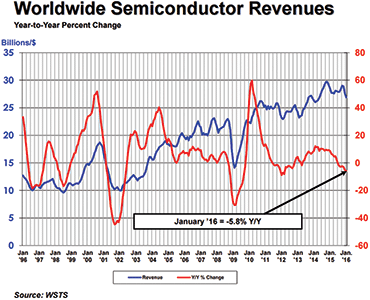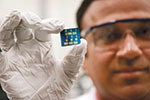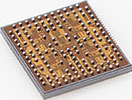
South Africa
• Jasco enjoyed a strong second half of 2015, with an increase in headline earnings per share (HEPS) of 783% to 5,74 cents. Group revenue of R558,1 million increased by 11,1%, driven by strong growth in both the Carrier and Intelligent Technologies businesses. Electrical Manufacturers’ revenue was flat compared to December 2014 due to lower than expected demand from its major customers, while the Enterprise business was 11% down due to the delay of two major projects into the second half of the financial year.
Overseas
Business
• Analog Devices announced financial results for its first quarter of fiscal year 2016, which ended 30 January. Revenue totalled $769 million, down 21% sequentially but stable year-over-year, while diluted earnings per share (EPS) were $0,52, compared to $0,57 for the first quarter of 2015 and $0,30 for the fourth quarter of 2015.
• Unaudited results for ARM’s full year ended 31 December 2015 showed revenue of £968,3 million, a 22% increase over the prior annum. EPS increased 25% year-on-year to 30,2 pence. The company signed up 51 new processor licences in the fourth quarter of the year, during which period 4 billion ARM-based chips were shipped, up 16% year-on-year.
• Maxim Integrated Products reported net revenue of $511 million for its second quarter of fiscal 2016, a 9% decrease from the $563 million revenue recorded in the prior quarter, and a 10% decrease from the same quarter of last year. Earnings per share amounted to $0,23.
Companies
• Foxconn, the world’s biggest contract electronics manufacturer, is making a bid for Sharp, but the deal is currently up in the air. After having issued a $5,8 billion takeover offer that was accepted by Sharp, Foxconn then put the deal on hold while it clarifies “new material information” it received. Rumours suggest that the information in question relates to contingent liabilities of Sharp totalling $2,7 billion.
Industry
• Global semiconductor sales got off to a sluggish start in 2016, as the Semiconductor Industry Association has announced worldwide sales of semiconductors were $26,9 billion for the month of January 2016, 2,7% lower than the previous month’s total of $27,6 billion and 5,8% down from the January 2015 total of $28,5 billion. Sales into the Americas were particularly poor, decreasing 5,9% month-to-month and 16,9% year-to-year. Sales also decreased across most major semiconductor product categories, with the notable exception of microprocessors, which increased year-to-year by 2,1%.

Technology

• University of Utah engineers have discovered a new kind of 2D semiconducting material for electronics. Made of the elements tin and oxygen, or tin monoxide (SnO), the semiconductor is a layer of 2D material only one atom thick, allowing electrical charges to move through it much faster than conventional 3D materials such as silicon. While researchers in this field have recently discovered new types of 2D material such as graphene, molybdenun disulphide and borophene, they have been materials that only allow the movement of N-type, or negative, electrons. The tin monoxide material is the first stable P-type 2D semiconductor material ever in existence.
• The Defense Advanced Research Projects Agency (DARPA) in the USA has developed an analog-to-digital converter fast enough to make RF communications unjammable by spectrum-based attacks. Built on GlobalFoundries’ 32 nm process, the chip samples and digitises signals at a rate of 60 GSps, generating 1 TB of data in a second. It also performs onboard processing so this massive volume of data need not all be transferred to a separate processor.
• A team of University of Washington computer scientists and electrical engineers has demonstrated that it’s possible to generate Wi-Fi transmissions using 10 000 times less power than conventional methods. The new ‘Passive Wi-Fi’ system also consumes 1000 times less power than existing energy-efficient wireless communication platforms, such as Bluetooth Low Energy and Zigbee. It works by assigning analog, power-intensive functions – like producing a signal at a specific frequency – to a single device in the network that is plugged into the wall. An array of sensors produces Wi-Fi packets of information using very little power by simply reflecting and absorbing that signal using a digital switch.
• At Mobile World Congress, mobile electronics developer Oppo demonstrated a reference device that can fully charge a phone’s 2500 mAh battery in just 15 minutes. Based on SuperVOOC quick-charging technology, the system reportedly works with both Micro USB and USB Type-C. Oppo announced a vague timeline of “in the near future” for commercial availability.
• Researchers at HRL Laboratories have achieved the first demonstration of gallium nitride (GaN) CMOS FET technology, and in doing so have established that the semiconductor’s superior transistor performance can be harnessed in an integrated circuit. This breakthrough could pave the way for GaN to become the technology of choice to supersede silicon in power conversion circuits.
• Scientists at the University of Southampton have made a major step forward in the development of digital data storage that is capable of surviving for billions of years. Using nanostructured glass, they developed recording and retrieval processes of five dimensional (5D) digital data by femtosecond laser writing. The storage allows unprecedented properties including 360 TB/disc data capacity, thermal stability up to 1000°C and virtually unlimited lifetime at room temperature (13,8 billion years at 190°C ).

• Nanoelectronics research centre Imec and Vrije Universiteit Brussel (VUB) have demonstrated a four-antenna path beamforming transceiver for 60 GHz, multi-Gbps communication in 28 nm CMOS technology. The transceiver is a breakthrough in developing a small, low-cost and low-power solution for multi-gigabit communication targeting WiGig as well as 60 GHz wireless backhaul applications. The prototype transceiver chip, which was implemented in 28 nm CMOS and measures 7,9 mm2, was validated with a IEEE 802.11ad standard wireless link of 1 metre. The transmitter consumes 670 mW and the receiver 431 mW at 0,9 V power supply.

© Technews Publishing (Pty) Ltd | All Rights Reserved